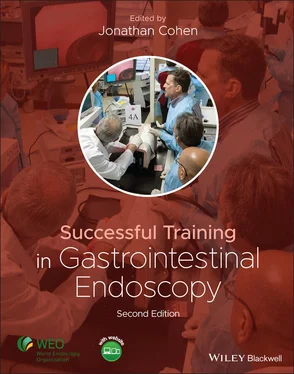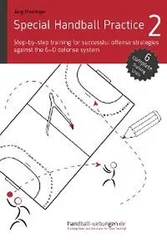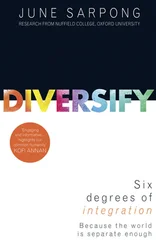Successful Training in Gastrointestinal Endoscopy
Здесь есть возможность читать онлайн «Successful Training in Gastrointestinal Endoscopy» — ознакомительный отрывок электронной книги совершенно бесплатно, а после прочтения отрывка купить полную версию. В некоторых случаях можно слушать аудио, скачать через торрент в формате fb2 и присутствует краткое содержание. Жанр: unrecognised, на английском языке. Описание произведения, (предисловие) а так же отзывы посетителей доступны на портале библиотеки ЛибКат.
- Название:Successful Training in Gastrointestinal Endoscopy
- Автор:
- Жанр:
- Год:неизвестен
- ISBN:нет данных
- Рейтинг книги:3 / 5. Голосов: 1
-
Избранное:Добавить в избранное
- Отзывы:
-
Ваша оценка:
- 60
- 1
- 2
- 3
- 4
- 5
Successful Training in Gastrointestinal Endoscopy: краткое содержание, описание и аннотация
Предлагаем к чтению аннотацию, описание, краткое содержание или предисловие (зависит от того, что написал сам автор книги «Successful Training in Gastrointestinal Endoscopy»). Если вы не нашли необходимую информацию о книге — напишите в комментариях, мы постараемся отыскать её.
Teaches trainee gastroenterologists the endoscopic skills needed to meet the medical training requirements to practice gastroenterology and helps clinical specialists refresh their skills to pass their recertification Successful Training in Gastrointestinal Endoscopy, Second Edition
Successful Training in Gastrointestinal Endoscopy, Second Edition
Successful Training in Gastrointestinal Endoscopy — читать онлайн ознакомительный отрывок
Ниже представлен текст книги, разбитый по страницам. Система сохранения места последней прочитанной страницы, позволяет с удобством читать онлайн бесплатно книгу «Successful Training in Gastrointestinal Endoscopy», без необходимости каждый раз заново искать на чём Вы остановились. Поставьте закладку, и сможете в любой момент перейти на страницу, на которой закончили чтение.
Интервал:
Закладка:
While simulators are likely to play an increasingly important role in endoscopic training and retraining, key gaps were identified that must be addressed for simulation to have an even greater impact on endoscopic training. These include
1 Improved visual resemblance and haptic capabilities of computerized modules
2 Incorporation of more complex cases to enhance the range of difficulty and increase relevance for the skilled endoscopist
3 Improved functional task alignment of simulators with real‐life performance (i.e., similar sensory, cognitive, and/or motor processing required for the simulator as for the corresponding clinical task)
4 Simulator‐generated performance metrics with strong validity evidence to enhance assessment capabilities and provision of feedback and increased capacity for independent practice
5 Improved discriminative validity, capable of distinguishing between endoscopists with small differences in skill
6 Inexpensive portable models to facilitate local access to simulators
7 Cognitive training tools targeting lesion recognition and management decision‐making skills
8 Simulators for more complex procedures such as ERCP and EUS and low‐volume, high‐stakes therapeutic techniques.
Ongoing evolution of endoscopic training
The past two decades have been characterized by rapid expansion of the training modalities at our disposal and the general acceptance of their use. Much work remains to clarify the optimal way to integrate these tools into standard training, training in advanced procedures, and in the uncharted waters of maintaining skills.
 Several challenges exist as endoscopic training continues to evolve. To date, the vast capacity to incorporate the trove of stored video and photographic content covering endoscopically encountered pathology and how to manage it has been greatly under‐utilized. The DAVE Project [64] was launched in 2004 and represented a significant advance in allowing for free and easy access to view much of this kind of material (Video 1.7). Converted in 2013 to Apple podcasts, the DAVE Project stored annotated videos on an enormous range of common and uncommon findings, as well as demonstrations of typical and unusual procedures. Similar contact is now found in newer online platforms, including Video GIE ( https://www.videogie.org). However, there is still very limited incorporation of this material into web‐based interactive learning opportunities. By taking advantage of broadband transmission and web‐based learning, cognitive training might undergo as great a transformation in the coming years as ex vivo models have provided for technical skills development.
Several challenges exist as endoscopic training continues to evolve. To date, the vast capacity to incorporate the trove of stored video and photographic content covering endoscopically encountered pathology and how to manage it has been greatly under‐utilized. The DAVE Project [64] was launched in 2004 and represented a significant advance in allowing for free and easy access to view much of this kind of material (Video 1.7). Converted in 2013 to Apple podcasts, the DAVE Project stored annotated videos on an enormous range of common and uncommon findings, as well as demonstrations of typical and unusual procedures. Similar contact is now found in newer online platforms, including Video GIE ( https://www.videogie.org). However, there is still very limited incorporation of this material into web‐based interactive learning opportunities. By taking advantage of broadband transmission and web‐based learning, cognitive training might undergo as great a transformation in the coming years as ex vivo models have provided for technical skills development.
A second major area for progress is in the area of creation and validation of simulator‐based skills assessments that predict performance level and competency on actual procedures. Simulator investigators have long realized that a key milestone would be the development of reliable simulator‐based assessments of competency.
A third area that will need to be addressed in coming years is the further integration of some of these new teaching modalities into local programs. For example, the ideal follow‐up of the national first year’s fellows hands‐on training experience at the ITT would be follow‐up hands‐on workshops at various intervals run and funded locally with support of local physicians and industry. Funding and logistic issues need to be addressed, but adoption will first require increased acknowledgment by local program directors of the importance of such activities. For example, a combination didactic and hands‐on training course for advanced and interventional endoscopy held regionally may be an alternative to a centralized approach. To date, such workshops at professional society national and regional meetings (such as at ASGE, ACG, and NYSGE meetings) have emerged, but have not yet been scaled to reach the vast majority of GI trainees. Further expansion of hands‐on ex vivo simulator training at the local level will also require a considerable effort to train a broader group of trainers on how best to utilize these simulators to teach endoscopy [38] (see also Chapter 4).
Finally, what about the introduction of new endoscopic technology and techniques? This would be another area of real promise for an expanded role of simulators and specific training program development. On the part of industry, this begins with the use of models to test early devices and procedures prior to more costly animal studies. Next is the growing recognition that innovative techniques require specific training programs to ensure both proper execution of the new procedures and acceptance of the innovation by practitioners. Busy clinicians will not adopt new skills unless an efficient and preferably validated training program is available to ensure that they can develop the proficiency to safely and effectively do the procedure. In contrast to the past when efforts to determine the best ways to train for techniques often came long after the procedure was adopted, in the future, there will be increasing pressure to address training upfront. One hopes that with this additional attention to training in parallel with technology development will come increasing avenues of support for simulator‐based training in general. This may be of particular importance as a partial solution to the problem of creating more opportunities for practicing endoscopists who desire to and will need to learn new techniques. The innovators will need to support those they hope will adopt the innovation; simulators are likely to facilitate this growing interdependence.
It is clear that since 2000, there has been an increased focus on how endoscopic training should occur and on achieving benchmarks for assessing progress before further training should continue. Progress in simulation has been steady but remains slow, yet sentiment for engaging both trainees and experienced endoscopists for simulator training is evidenced by summits, White Papers, and continued innovation. Moreover, there continue to be progress in e‐learning, accelerated by the expanded use of video recording, and easier access to high‐quality material with distribution by broadband internet and advertisement and amplification on social media platforms.
A peek into the future of endoscopic training to 2030
So where is endoscopic teaching likely to go? While the future is always hard to predict, certain things seem to be on the horizon. In general, one can predict increased training done by sharing of educational videos on platforms that are accessible worldwide. (see Table 1.2for a summary of likely features of endoscopic training by 2030).
These changes to video and remote learning were already moving into place, but the COVID‐19 pandemic of 2020 and beyond may have accelerated this development. Important driving factors here include:
Table 1.2 A look at endoscopy training in 2030.
| Introductory learning assessment tools to identify personal learning styles and skills at outset:Verbal, visual, and tactile assessments to facilitate subsequent trainer–trainee interactionApplication of ongoing assessment tool data collection and AI‐enhanced digital mentoring to focus training on areas in need of greater attention to accelerate learning curves.Wider availability and full incorporation of simulators throughout the training processStaged simulator integrationNovices prior to patient experienceAdvanced beginners prior to participation in therapeuticsIntermediate/senior fellows to refine skills and practice entire techniques with team trainingAdvanced endoscopists learning new or complicated high‐risk and low‐volume procedures.Web‐based tools with self‐assessment to teach an array of cognitive skills and lesion recognitionCoupling of appropriate simulator‐based lesson plans and model types with particular stages of training or learning goalsDevelopment of training director consensus and professional society guidelines on specific applications for simulator work within trainingObjective competency assessment tools developed and adopted by training programs for each specific technique—expansion beyond current EGD, colonoscopy, ERCP and EUS tools (e.g., Barrett’s ablation; endoscopic mucosal resection; endoscopic sleeve gastroplasty (ESG)).Adoption of skill and technique‐based certificates of competency based on repeated demonstration of objective measures of performance based on validated tools.AIInteraction between AI‐powered personal digital mentors and professional society learning platforms for access to tailored educational content.Full integration of AI into training as well as endoscopic practice. For training, AI will guide progress of lesson plans and acceleration of development of cognitive skills such as lesion recognition and appropriate interpretation and management of findingsExpanded use of social media communication to accelerate learning and information sharing among trainees.Mobile phone accessible atlas, guideline, and other searchable educational resources.Wide growth in use of remote video mentoring and proctoring, particularly in low‐volume techniques.Perhaps, further increased sub‐specialization of endoscopic training—EUS/ERCP; resection; bariatric endoscopy, hospital urgent endoscopy [obstruction, bleeding].Development of certification examinations for endoscopy to standardize credentialing and re‐credentialing process.Development of endoscopy‐specific continuing medical education (CME)/maintenance of certification (MOC) activities.Wider capture of endoscopy practice outcomes, establishment of standard quality benchmarks for more specific techniques, and development of validated remediation training modules for underperformers.Improved tailoring of training to workforce needs by geographic location.Major shifts in training program time allocations as screening colonoscopy faces competitive strategies, and other areas such as bariatric endoscopy grow in demand.Formal adoption of train‐the‐trainer programs by US training programs as part of faculty development.Major move to online educational platforms for courses, lectures, video case discussion. Wider access for remote audience to acclaimed experts and challenges to provide engaged interactive learning opportunities. Will GI training programs integrate lectures and grand rounds from outside educational providers [private or professional society sources] or continue to each develop their independent conference agenda each year to meet the common curricular requirements?Collaboration across professional societies and involving regional professional societies will grow to avoid redundancies and increase efficiency in endoscopy education.Industry funding for training and education will be uncertain.Active participation in endoscopy research as part of training may become marginalized to fewer training programs and centers.Decreased emphasis on annual scientific large meetings with greater focus on smaller topic‐specific conferences and increasingly virtual formats over in‐person gatherings. |
1 The COVID‐19 pandemic has led to sharply increased interest and then sudden acceptance of video platforms that turn out to be easily accessible worldwide. Learning in remote parts of the world has been made simple and affordable. Rather than bringing equipment and personnel to remote parts of the world, technology allows for the teachers to both teach and supervise from afar. Indeed, despite being retired from active clinical practice, Dr. Jerome Waye, a true pioneer in endoscopy and colonoscopy and in its education, is again pioneering by leading this new wave of remote teaching and proctoring. In 2020, he was able to bring “video‐mentoring” to Uganda and other parts of the world ( Figure 1.14) (Video 1.8). [See insert for a first‐hand description of this project by Dr. Waye.]
Читать дальшеИнтервал:
Закладка:
Похожие книги на «Successful Training in Gastrointestinal Endoscopy»
Представляем Вашему вниманию похожие книги на «Successful Training in Gastrointestinal Endoscopy» списком для выбора. Мы отобрали схожую по названию и смыслу литературу в надежде предоставить читателям больше вариантов отыскать новые, интересные, ещё непрочитанные произведения.
Обсуждение, отзывы о книге «Successful Training in Gastrointestinal Endoscopy» и просто собственные мнения читателей. Оставьте ваши комментарии, напишите, что Вы думаете о произведении, его смысле или главных героях. Укажите что конкретно понравилось, а что нет, и почему Вы так считаете.












